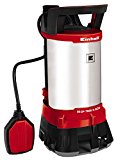Pond pump purchasing advice: how to choose the right product
- What You Need to Know
- Pond pumps give life: By circulating the water, they enrich it with oxygen. This ensures the survival of many aquatic inhabitants.
- Additionally installed filters keep the pond water free of algae and sediment.
- The pumps move water within the pond and beyond. This is what makes fountains and water features such as cascades possible in the first place.
- Pond pumps are suitable for a wide variety of applications in natural ponds, swimming ponds and fish ponds.
- As a rule, the greater the flow rate, the greater the delivery head.
What are pond pumps used for?
Pond pumps are the backbone of a functioning, living garden pond. They not only pump water and introduce oxygen into the water during circulation, but often also run through a filter system that removes algae as well as suspended matter and thus keeps the pond clean.
Reduce the danger to animals with a pre-filter
Pumps are often a danger to small animals such as newts, tadpoles and various larvae: these are sucked in through large inflow openings and then get caught in the pump blades. As a rule, the pond inhabitants do not survive this. You can counteract this danger by installing a fine pre-filter on the suction side. This is possible with almost all pump models.
The different types
Those interested in buying a pump do not have it easy when looking for a suitable pump model. The products are offered not only under the name of pond pump, but also as filter pump, stream pump and water feature pump. First of all: they are all pond pumps. But it is important to differentiate according to the purpose of use.
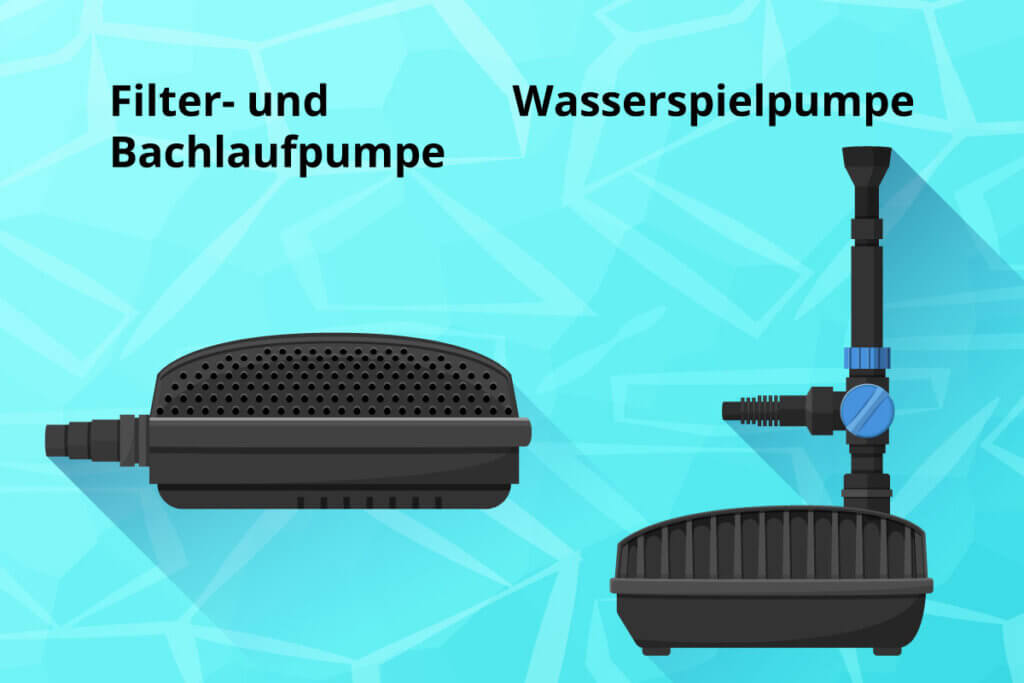
Models that are mainly used for pumping water are usually referred to synonymously as filter pumps or watercourse pumps. Here, it is primarily a matter of the circulation capacity and the delivery in the direction of a water filter. When we speak of a pond pump, we are usually referring to a filter or stream pump. It is suitable both for filter operation and for feeding a stream or waterfall. Since the pump blades do not reach the edge of the pump chamber, a rapid drop in performance is to be expected as the height increases.
Water feature pumps, on the other hand, are primarily used to decorate the pond. For example, they feed a water fountain or a fountain. Although they have a high operating pressure to achieve the intended head for a water feature, they are not suitable for feeding a pond filter for water circulation. Such a water feature pump usually comes with various attachments such as a bell, goblet or volcano attachment. With these types of pumps, the delivery blades reach right up to the edge of the pump chamber. This moves the water with more force. This means that more pressure is built up, which can move the water to great heights. However, the same amount of energy is required to move far less water than with filter pumps. Use as a filter and watercourse pump would be uneconomical.
Finding the right pump
As soon as you have found out whether a filter or watercourse pump or a water feature pump is better suited to your purpose, you can include a number of other purchase criteria in the decision-making process when choosing a model. Among other things, the delivery head and flow rate, the energy consumption, the operating voltage and the installation location are important.
Type of installation and voltage
A decisive criterion in choosing the right pond pump is the question of the installation location: there are pumps that are installed wet, i.e. positioned in the water, and those that are installed dry, i.e. outside the water and suck in the water themselves.
A distinction must also be made between pumps that operate at 230 volts and those that operate at 12 volts. It is forbidden to operate wet models with 230 volts unless you secure access to the pond with a high fence: the danger of a life-threatening electric shock is too great, especially for children and animals. Unfortunately, some private users do not comply with this – perhaps out of ignorance. So first of all you should check whether the high power class is necessary for your installation at all.
For such an application, 12-volt pond pumps are much more suitable, as the risk of accidents can be excluded here. This is referred to as safety extra-low voltage. In the meantime, 12-volt models are so powerful that they are sufficient for the majority of private users’ purposes. They can be operated directly in water. Experience shows that these pump models are the ideal solution for 80 percent of ponds. Only in the case of large quantities of water that need to be transported or large delivery heights that need to be bridged are 230-volt models the better choice. If you still need a more powerful unit, it is mandatory to operate the pump at least two metres away from the pond. This can be done in a separate shaft, for example.
Energy consumption
The energy consumption is given in watts. If the model is in continuous operation for one hour, the specified wattage – for example 90 watts – is consumed. 1,000 watts, i.e. 1 kilowatt, is the unit of consumption that you settle with your electricity provider once a year. Since pond pumps are in constant use during the frost-free season, investing in an energy-saving model pays off quite quickly.
The greater the volume of water and the height to which the water has to be transported, the more the pump has to work – and the higher the electricity bill accordingly. When the power decreases, a fountain, for example, no longer reaches the desired height, which can be easily determined. The situation is different with a stream. Here, the problem can remain undetected for a long time.
Electronically monitored pumps register a drop in performance and increase the output – but this also leads to a considerable increase in electricity consumption. In the worst case, a clogged pump suddenly consumes several hundred watts, which can come as a nasty surprise on the electricity bill.
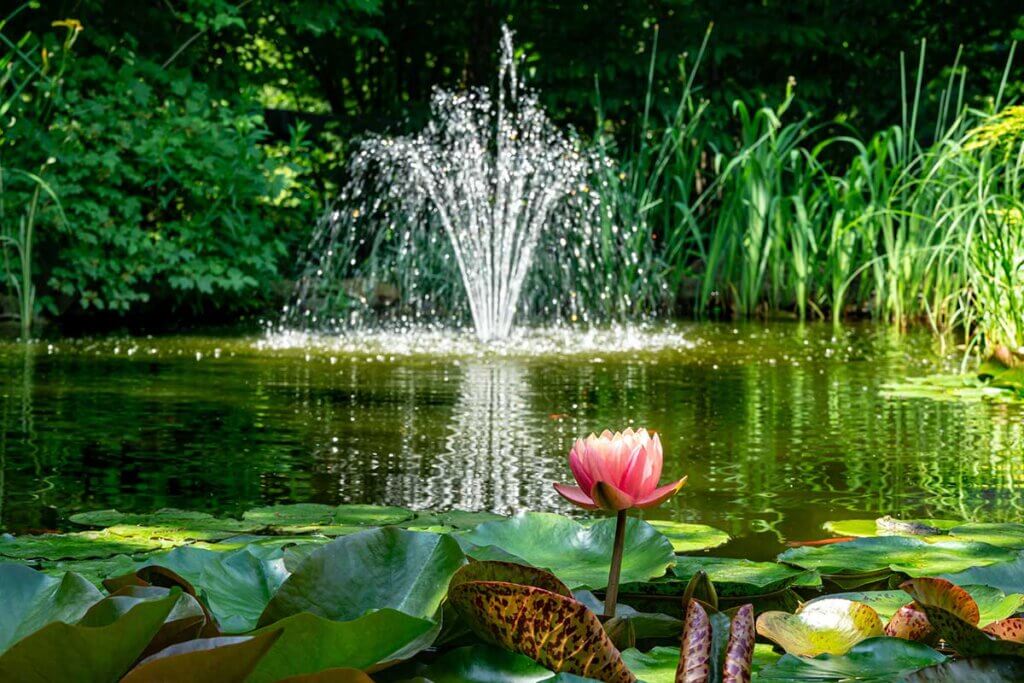
Solar pond pumps are worthwhile for some purposes where the amount of water and the delivery head are not too large. Some models have a rechargeable battery so that energy is available to pump water even when there is little sunlight or at night. In good weather, solar models can save on electricity costs.
Maximum head
The maximum delivery head is indicated on the packaging and on the type plate of the unit. In tabular form, the maximum delivery head is often given under the abbreviation “H (max)”.
A widespread misunderstanding: the maximum delivery head of a pump does not mean that it can pump water at full pressure up to this height. Rather, the maximum delivery head indicates the point to which water can be transported upwards. To illustrate, this means the following: Assuming you are standing on a long ladder and holding a garden hose vertically in the air at a height of exactly ten metres in your hand, the pump can convey the water exactly to the end of the hose, but cannot cause it to run out.
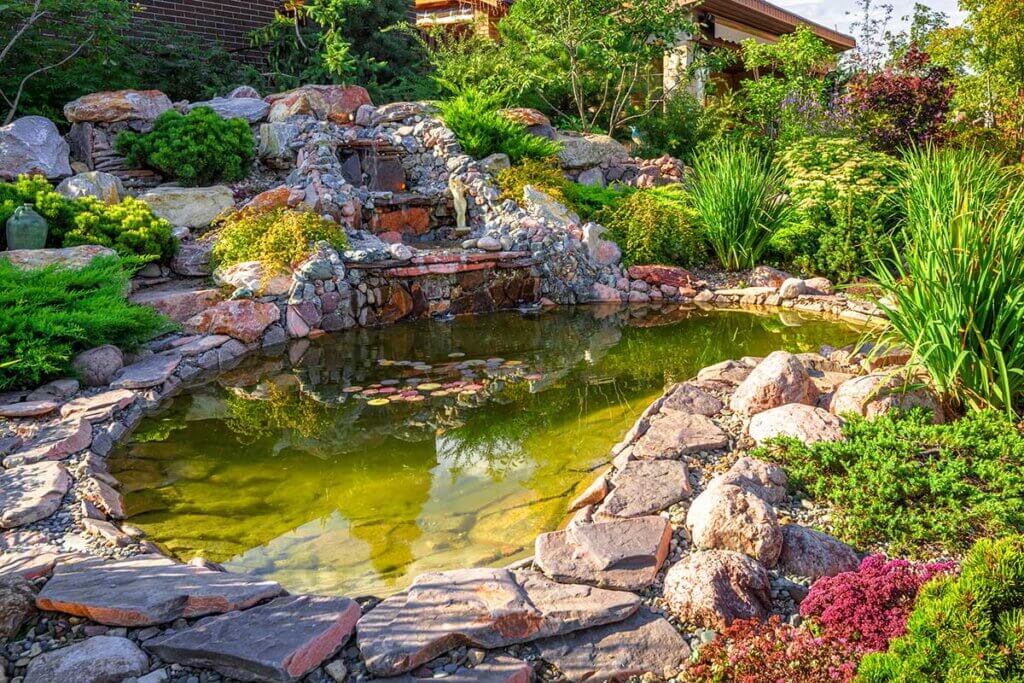
Maximum flow rate
The maximum flow rate – abbreviated as Q (max) – is the maximum amount of water that can be moved through the pump per hour. This quantity is specified either in cubic metres (m³) or in litres (l). 1 cubic metre corresponds to 1,000 litres. This maximum specification refers to ideal conditions: Assuming it is standing on the ground, there is water all around and it does not have to dispense the liquid over long distances and without height differences, the maximum delivery rate is achievable.
For a small garden pond with a filling volume of less than 10 cubic metres, pump models with a circulation capacity of around 1,000 litres per hour are sufficient. For a large number of larger garden ponds, a model with a flow rate of 5,000 litres per hour is a good choice. Large fish ponds, such as ornamental ponds for koi, should be equipped with a large filter pump with a flow rate of up to 25,000 litres.
Too high a delivery rate is not only bad for the wallet and the environment: overflowing of the filter or bursting of the pressure filter are also possible dangers of incorrect dimensioning.
What influences the flow rate of a pond pump?
There are many factors that affect the water delivery rate. These include the length as well as the delivery height of the hose line. The further the water has to be transported, the lower the pressure that arrives at the end of the line. The transport distance from the pump to the source, for example, reduces the pressure. This is relevant, for example, if the unit is operated outside a pond. The same applies to the water outlet, which can be located at a water feature installed above, a fountain.
The hose diameter is also important. The smaller the diameter, the more pressure the pump has to apply to pump the water. The longer the hose, the greater the pressure loss. Since a hose with a larger diameter hardly causes any additional costs compared to an ordinary garden hose, you should rather invest in a hose with a larger diameter than in a stronger pump. The minimum recommendation is a hose diameter of 1.5 inches (3.81 centimetres). This ensures a lower pressure loss. Also, unlike small garden hoses, large-diameter hoses are reinforced with wire so that they can be laid underground without being crushed by the weight.
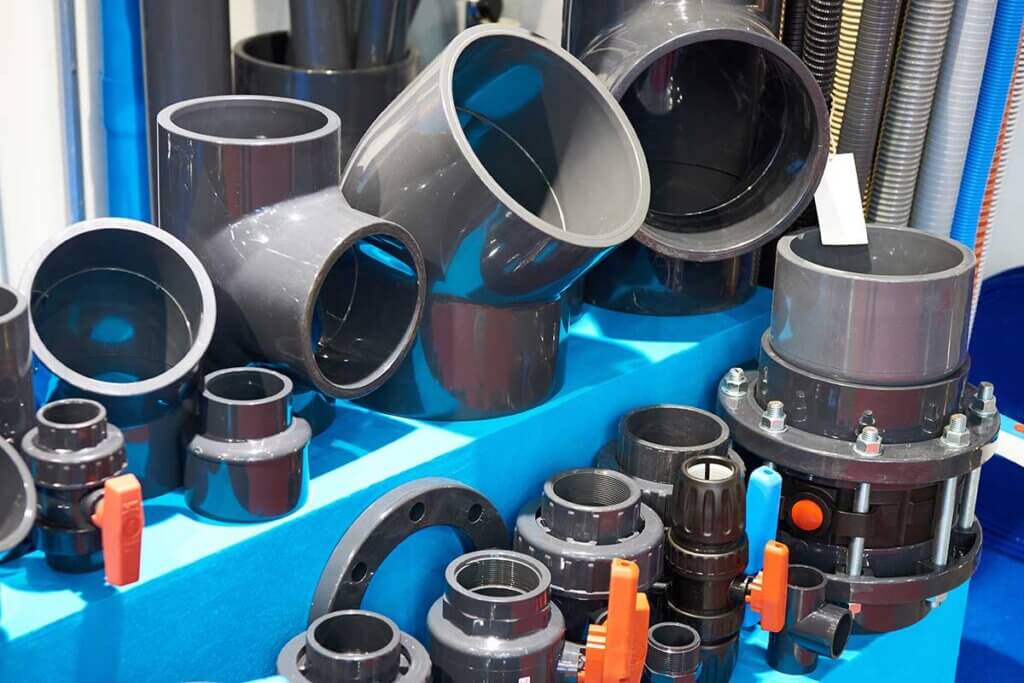
Another way to influence the flow rate is to use so-called fittings. These are connecting pieces with threads. They can be 90-degree elbows, Y- or T-pieces that increase the diameter and thus take pressure off the pipe, or pipe sections with ball valves or gate valves that you can use to manipulate the flow rate. However, it is better to regulate the power of the pond pump or directly choose a model with a lower power, because a downstream reduction of the flow rate does not reduce the pump power, i.e.: it is a waste of energy.
Water flow and pump diagram
When choosing the right pump model, it is important to look at the pump manufacturer’s diagram. It gives you information about the combination of head and flow rate. This combination is far more informative than the information on the water quantity alone. If you have found several models with suitable delivery head and flow rate on the basis of the diagram, you should choose the device with the lowest power consumption. This will save you a lot of money in the long run. In addition, such a model meets your requirements and no power reserves are lost. This also protects the environment.
Can the pump curve help me decide which model to buy?
The pump characteristic curve or pump diagram is a compulsory indication by the manufacturer that allows a statement to be made about the flow rate in relation to the delivery head. It shows the pressure loss to be expected with increasing delivery head. The delivery head is therefore taken as a basis for the expected water volume. The measurement is taken from the water surface to the outlet, which can be a filter outlet or a belly outlet, for example. The flow rate is then read off the characteristic curve for the desired outlet height. This calculation ignores line obstructions such as bends, valves and UV lamps, which cause a further drop in pressure.
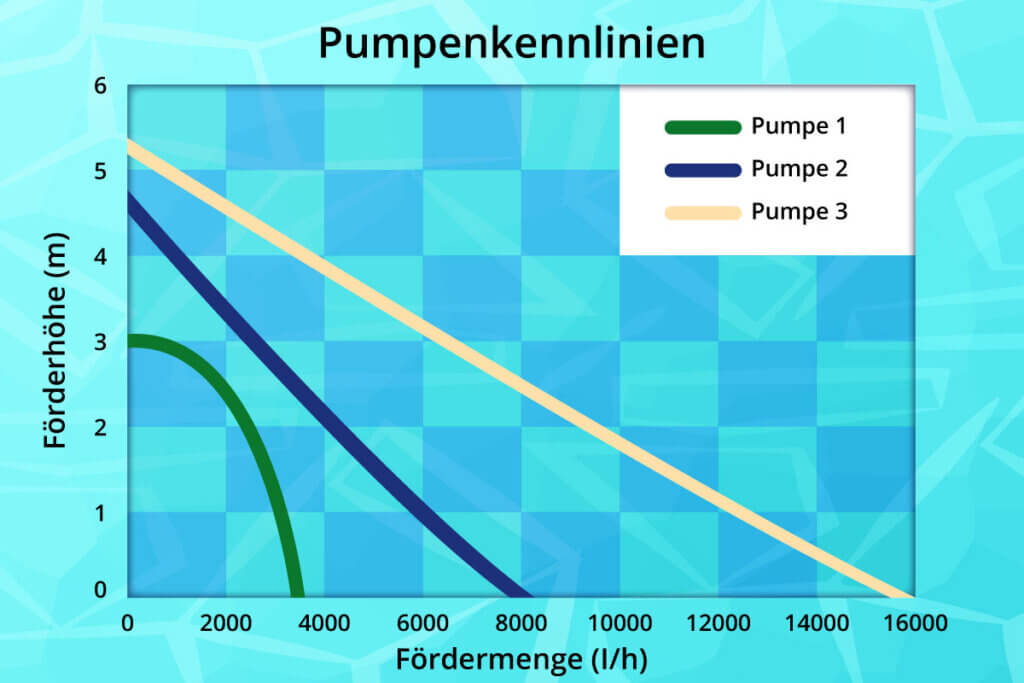
The lines are not linear, but differ from model to model. For example, the amount of water at a delivery head of three metres can be very different for two different pond pumps. Assuming a higher delivery head, one pump will still have limited performance, but another may not deliver any water at all.
Where is the ideal location for a pond pump?
A pond pump should not be operated in very shallow water, as there is a high risk of it running dry and thus becoming defective. Deep water is also not ideal, as there is an increased risk of silting up. A water depth of 30 to 40 centimetres is ideal. For many 230-volt models that are operated continuously, an installation location outside the pond is recommended, ideally in a shaft at least two metres from the shore.
Should I clean the pond pump regularly?
The lifespan of a pump depends not only on the quality of the components but also on regular maintenance. On the one hand, you should already pay attention to whether the manufacturer offers replacements for wearing parts when buying. On the other hand, it is advisable to service the device regularly. To do this, take it out of the pond, open the housing and clean it of mud and other dirt such as leaves, grass or algae that reduce the water flow. This maintenance should take place at least once a year, ideally in the middle of the season. It is also advisable to decalcify the water-conveying parts. Special descaling tablets and liquid solutions are available for this purpose. In winter, after cleaning, the pumps should be stored in the frost-free cellar in a bucket filled with water. This ensures that the rubber seals also become porous and crumble. Often these cannot be replaced.

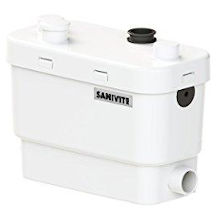
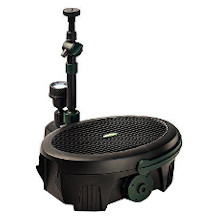
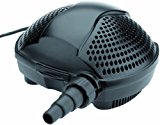
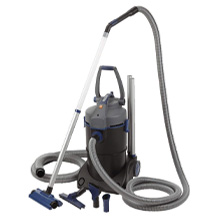
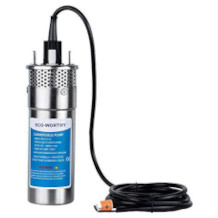

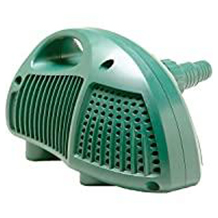
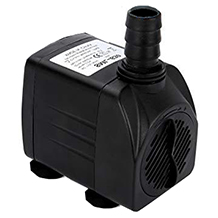
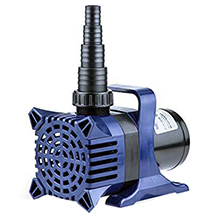
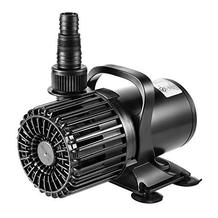
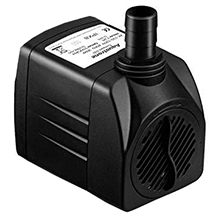

 2,424 reviews
2,424 reviews

